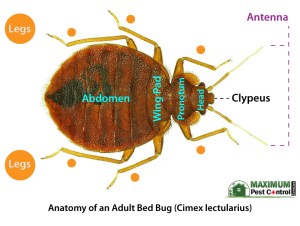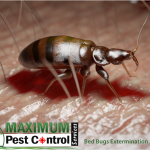
What Colors Do Bed Bugs Prefer?
These little insects-pests invade our houses, disturb our sleep, and have other sinister aims against us. But few know that their behaviours can be influenced to some extent by colors. The color preference of bed bugs can give valuable insights into their behavior. Consequently, it could perhaps help in controlling the infestation of these insects. This post is all about exploring bed bugs and color science: what colors they like and why?
Understanding Bed Bug Behaviour
Bed bugs are nocturnal insects that feed solely on human blood. When their hosts are asleep at night, their activities are most active. These pests take their cue from the warmth and carbon dioxide that humans emit to find their next meal. While these facts of bed bugs are well-known to most people, few really understand how color factors into their behavior.
Current research has drawn attention to the colors that bed bugs prefer, as it always gives reasons for lurking areas and feeding behavior. This color preference is not some aberration of nature but rather is rooted in their very survival instincts. These color preferences are also an indicator of how one may go about safeguarding their homes from these unwanted bedfellows.
The Science Behind Color Attraction
In a study conducted by University of Florida researchers, bed bugs were put into several differently colored harborages and tested for preference. To view bed bug behaviours under replicated conditions, small tents are made out of colored cardstock.
The results were interesting. Bed bugs had a clear preference for some colors over others. They preferred the colors red and black, and they showed the least interest in the yellow, green, and white colors. The explanation for these preferences lay hidden in the biology and evolutionary history of bed bugs.
Why Bed Bugs Love Red and Black
One of the major reasons bed bugs are attracted to red has to do with the color being reminiscent of blood, which is their major food. Even though bed bugs do not always rely on color vision, as humans do, they are likely to associate red with a meal. Red may remind bed bugs of other bed bugs because this color is also the color of their exoskeletons. This association with conspecific bed bugs may indicate that red acts as a cue for a safe and common location.
The colour black is often related to darkness. Bed bugs are nocturnal insects, that means they rest in dark, covered places during the day. Black may just replicate the shady spots that these bugs like to disappear into, which will make them go after that. They offer the security of protection from predators and keep them in hiding until it is time for feeding.
Dislike for Yellow, Green, and White
Curiously enough, bed bugs avoided colors such as yellow, green, and white. These colors are, by nature, brighter and might remind them of daylight or open space against which the bed bug would instinctively act adversely. Yellow and green, in particular, could remind bed bugs of plants or outdoor settings, mainly where there is less likely to be a host for feeding.
White, on the other hand, is a shining color and hence less attractive to bed bugs. White reflects light and can expose them to threats. Generally, bed bugs avoid places that are well lit since they depend on concealment and shade to survive. This preference for darker colors and avoidance of lighter colors is an adaptation towards safety and concealing one’s presence.
Bed Bug Control: Implications
Understandably, bed bug color preference does have some practical implications in the way one attempts to either control pest infestations or prevent such cases. Although color alone is not going to keep your home bed bug-free, it could be one of several other factors you could consider to make your environment unwelcoming to bed bugs. The ways you may put this knowledge to work are:
Making Smart Choices in Bedding and Furniture
Since bed bugs are attracted to red and black, you may want to avoid these colors for bedding, furniture, or other items in the bedroom. Instead, use lighter colors, like white, yellow, or green. While this will not prevent an infestation, it may lower the possibility of bed bugs migrating to specific areas.
Monitoring and Trapping Bed Bugs
Traps and monitors are available that can be used to capture bed bugs in an existing infestation. Some of these traps take advantage of color preferences of bed bugs using red or black as a color attractant. These may be placed strategically around your home to help reduce the bed bug population and to monitor for their activity.
Bed Bug Inspections Tips
Being able to know their color preference during inspections helps in identifying possible places they may be hiding. Being fond of dark colors, bed bugs make inspectors pay more attention frequently to places where dark-coloured fabrics, furniture, or any such other material is found. In turn, this increases their chances of early detection before the level of infestation worsens.
The Limitations of Color in Bed Bug Control
Though colorful knowledge of preferences is interesting and can be helpful, keep in mind that this is another piece of the bed bug behavioral puzzle. They are resilient and resourceful insects capable of surviving in a wide range of environments: hot or cold, humid or arid. Other influencers such as temperature, humidity, and whether a food source is nearby also drive bed bugs.
Color should not be relied upon as the sole control means; it should form part of integrated pest management. This involves regular inspection, sanitation, and treatment by a professional. Bed bugs can hide in a number of areas other than color matching sites. Detection and treatment must be thorough.
Other Aspects of Bed Bug Behaviour
Aside from color, there are various other parameters for bed bug behavior. An understanding of these can provide a fuller perspective into bed bug management.
Temperature and Humidity
Bed bugs like to be warm-once again between 70°F and 90°F are typical. In cooler temperatures, they are less active and will hibernate if the environment is less than perfect. They like it moderately humid. If it’s too dry, it is too difficult to survive so they typically would live in more humid portions of the environment.
Odor and Pheromones
Bed bugs also react to chemical stimuli or pheromones. They employ these to communicate with one another, find a mate, or seek out a feeding site. Certain smells, such as that of carbon dioxide, are particularly attractive to bed bugs because they indicate host presence. Some pest management approaches utilize active chemical attractants to entice bed bugs into traps.
Human Behaviours and Movements
Human behavior plays a huge role in the development of bed bug infestations. Bed bugs readily hitchhike into homes while travelling on items such as luggage, clothing, and personal items. Once inside, they will be attracted to potential sleeping sites and specifically within areas where people typically sleep, such as beds, couches, and chairs. Bed bugs can also spread within a home because of common movements and/or transportation of materials.
A Multi-Faceted Approach to Bed Bug Control
Though the color preference of bed bugs may be an interesting insight into its behavior, effective control and prevention demand a multi-faceted approach. Knowledge about color preference applied with other measures like temperature control, managing scents, and observing human habits create conditions less welcoming for bed bugs.
Keep in mind that though avoiding red and black fabrics and using more light-coloured fabrics may reduce the bed bug’s attraction, this does not protect you entirely. For effective bed bug control, regular inspections, good sanitary conditions, and expert pest control services are of utmost importance.





